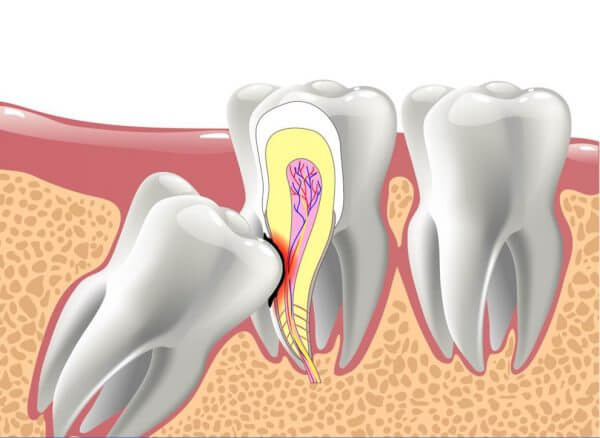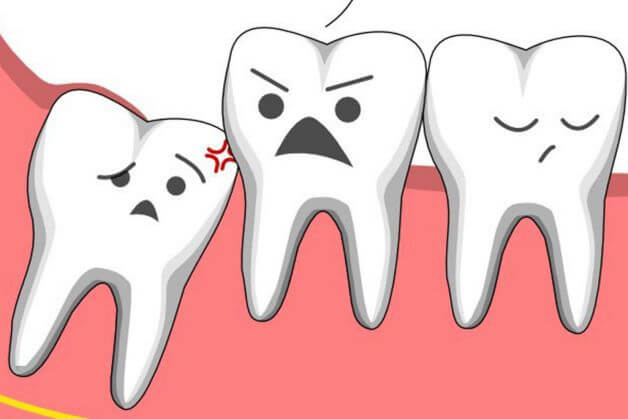Wisdom teeth growing crooked is an extremely common condition. The misalignment of wisdom teeth often causes many people to feel bothered and uncomfortable, significantly affecting their quality of life.
What are wisdom teeth?
Wisdom teeth, also known as “third molars,” are the last set of four molars in our dental arch. Typically, wisdom teeth begin to emerge between the ages of 17 and 25. The term “wisdom teeth” comes from the fact that they emerge when we have matured physically.
Although wisdom teeth can serve a purpose in chewing food, they often encounter issues during their development. Wisdom teeth commonly grow crooked, at an angle, or lack sufficient space to emerge properly, posing challenges in chewing, trapping food particles, and being difficult to maintain hygiene.

The decision on how to handle wisdom teeth often depends on the specific condition of each individual. In some cases, extracting wisdom teeth may be a solution to avoid issues with the gums and other teeth, while others may choose to monitor their development safely.
Signs of crooked wisdom teeth
Signs of crooked wisdom teeth may include:
Pain and inflammation: Crooked wisdom teeth can cause pain and inflammation in the surrounding area, especially if they press against adjacent teeth or gum tissue. This pressure can lead to food impaction and difficulties in maintaining oral hygiene, resulting in gum inflammation.
Tilted or misaligned teeth: Wisdom teeth may grow in the wrong direction, tilting or misaligning compared to other teeth due to insufficient space in the jaw.

Difficulty opening the mouth: Crooked wisdom teeth can exert pressure and make it challenging to open the mouth wide.
Swelling and gum pain: The gum around crooked wisdom teeth may swell, become painful, and sensitized due to the pressure from the growing process.

Exerting pressure on neighboring teeth: Crooked wisdom teeth can apply pressure to adjacent teeth, causing misalignment and potentially shifting other teeth.
If you experience any of these signs, it is advisable to visit dental facilities for evaluation and consultation regarding appropriate treatment options. Typically, wisdom tooth extraction may be recommended to prevent prolonged pain and other potential dental issues.
>> Read more: Top 4 Things to Note After Wisdom Tooth Extraction
Is it acceptable to leave crooked wisdom teeth unextracted?
Crooked and misaligned wisdom teeth can lead to several issues if not addressed appropriately.
In most instances, opting for wisdom tooth extraction is a prudent choice to prevent potential oral health complications. Crooked wisdom teeth can impede effective gum and tooth hygiene, resulting in gum inflammation and swelling. If the pressure from wisdom teeth affects neighboring teeth, it may cause tooth crowding, leading to misalignment and disrupting the overall aesthetic balance of the dental arch.
Furthermore, crooked wisdom teeth can induce pain and discomfort, particularly when opening the mouth or chewing. The decision on whether to extract wisdom teeth or not depends on the specific condition of the teeth and the surrounding gums. Dentists will offer advice and make informed decisions based on a thorough evaluation of the patient’s dental health.
The wisdom tooth extraction process
The procedure for extracting misaligned wisdom teeth is typically performed by a dentist or an oral surgeon. Here is a summary of the wisdom tooth extraction process:
1. Preliminary assessment of tooth condition: The dentist conducts a preliminary dental evaluation by directly examining the patient’s wisdom teeth.
2. X-ray imaging: X-rays are taken to assess the position and shape of the wisdom teeth within the jaw.
3. Preparing for tooth extraction: Before the extraction, the dentist informs the patient about relevant medical conditions and provides instructions on pre-surgery preparations, such as eating a full meal before the extraction, abstaining from alcohol, etc.
4. Performing the extraction or oral surgery: The procedure is usually carried out under local anesthesia or general anesthesia. The dentist opens the gum and removes the wisdom tooth. In some cases, the tooth may be divided into smaller parts for easier removal from the jawbone.
5. Closing the extraction site: After removing the wisdom tooth, the dentist closes the extraction site by suturing the wound.
6. Post-wisdom tooth extraction care: The dentist provides instructions for post-surgery care, including wound care, pain medication, and guidance on other relevant issues.
Nu Cuoi Duyen Dental Clinic – A reputable wisdom tooth extraction location in Binh Duong

Nu Cuoi Duyen Dental Clinic in Binh Duong is a reputable and professional dental destination. Our team of dentists is experienced and highly skilled, committed to providing patients with the best dental care experience.
The dentists at Nu Cuoi Duyen Dental Clinic not only master modern techniques but also prioritize the comfort and safety of patients. The wisdom tooth extraction process is performed carefully and meticulously, with clear explanations of the procedure and post-operative information provided to the patients.
Moreover, Nu Cuoi Duyen Dental Clinic receives high praise from customers for its comfortable clinic space, modern equipment, and clean environment. Patients can feel assured and confident when choosing this location to address their wisdom tooth concerns.
For more detailed information, please contact us via:
Hotline: 0834.122.312
Website: nhakhoanucuoiduyen.net (online chat frame)
(Or) Inbox our Fanpage here


